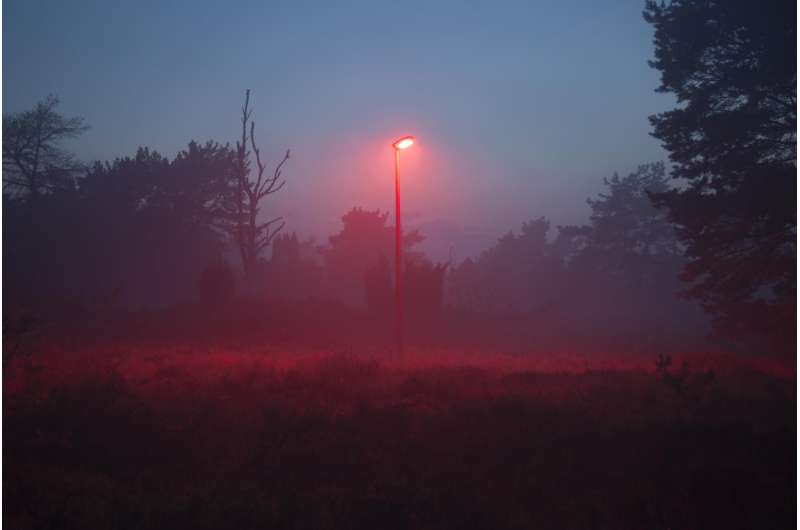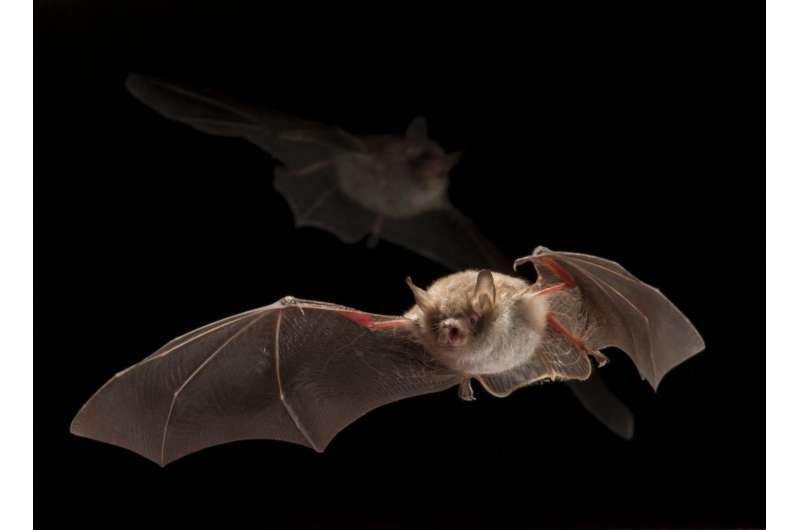Red light has no effect on bat activity: Less disruption by changing artificial color

Artificial light at night can have a disruptive effect on bats, but not if the light is red. Switching to red light may therefore limit or prevent habitat loss for rare, light-shy bat species. The latest issue of Proceedings of the Royal Society B publishes results from five years of pioneering research led by the Netherlands Institute of Ecology (NIOO-KNAW).
It's the first time researchers have succeeded in measuring the effects of light with different spectra on the activity of slow-flying, light-shy bats in their foraging habitat. "We've found these bats to be equally active in red light and darkness", says principal researcher Kamiel Spoelstra. "White and green light, on the other hand, substantially reduce the bats' level of activity."
The effect of red light on more common bat species such as the pipistrelle is reduced as well. Unlike a strong increase in activity of this species in white and green light, the activity in red light is comparable to darkness. This is caused by the strong attraction of insects to white and green (and not red) light. Pipistrelles opportunistically feed on these accumulated insects.
Real-life conditions
"The lack of effect of red light on both the rarer, light-shy species and the more common non-light-shy bats", concludes Spoelstra, "opens up possibilities for limiting the disruption caused by external, artificial lighting in natural areas, in situations where having light is considered desirable."
One of the things that make this research unique is that the intensity of the light used for the experiments holds up under real-life conditions. "In fact, it's entirely suitable for use on country roads." The scale and duration of the experiments also make them quite unique.

Bats hunt for insects at night because there's not much competition from other animals, and predators won't see them because it's too dark. Which is why artificial light can cause such disruption: less-common, slow-flying species such as Natterer's bat or the brown long-eared bat may feel vulnerable for visual predators like owls.
Agile flyers such as the pippistrelle, on the other hand, don't mind the extra light. On the contrary: streetlights come in handy for them for catching more insects. Larger bat species such as the serotine bat and the lesser noctule, finally, fly high and don't seem to care either way.
Control row
"So for the more common species", says Spoelstra, "artificial light can serve as a facilitator while less common species face potential loss of habitat." Together with fellow scientists from NIOO and Wageningen University, and partners including Philips Lighting, he tried to find out if adjusting the colour of the light could limit or prevent this effect.
Over a five-year period, the researchers studied bat activity under experimental white, green and red LED-light conditions. For this, they used the one of a kind facilities of the 'Licht op Natuur' ("light on nature" ) project: eight study sites along forest edges in dark parts of the Netherlands. Each study site consists of four rows of streetlights in a single colour, and a control row of unlit streetlights.
The Licht op Natuur project isn't 'just' about bats, however. The study sites are used to measure the effects of artificial light on a wide range of species including mice, larger mammals, plants, moths, soil animals and birds.
More information: Kamiel Spoelstra et al, Response of bats to light with different spectra: light-shy and agile bat presence is affected by white and green, but not red light, Proceedings of the Royal Society B: Biological Sciences (2017). DOI: 10.1098/rspb.2017.0075
Journal information: Proceedings of the Royal Society B
Provided by Netherlands Institute of Ecology


















